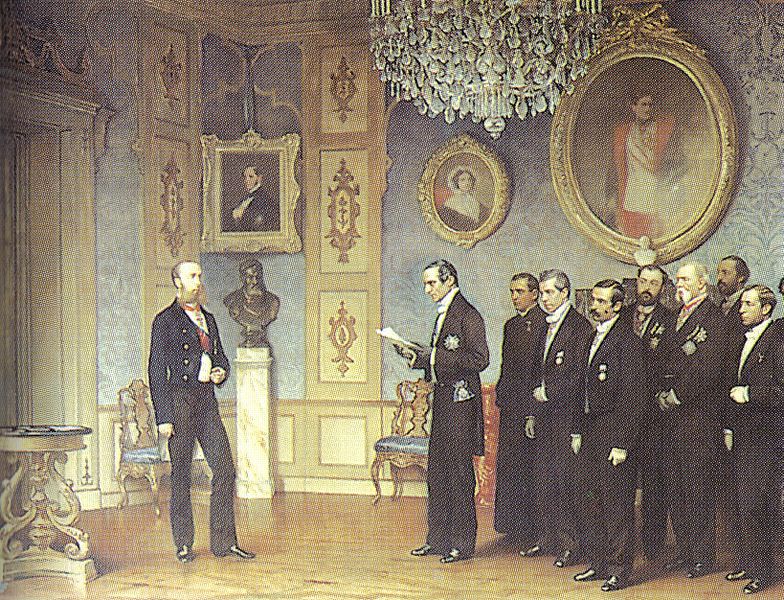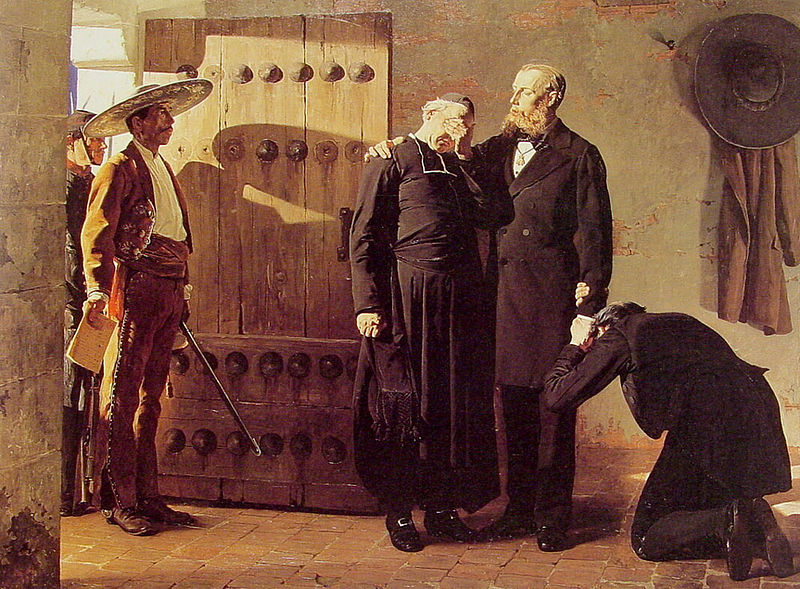<Back to Index>
- Philologist Vatroslav Jagić, 1838
- Writer Carl Gustaf Verner von Heidenstam, 1859
- Emperor of Mexico Maximilian I, 1832
PAGE SPONSOR
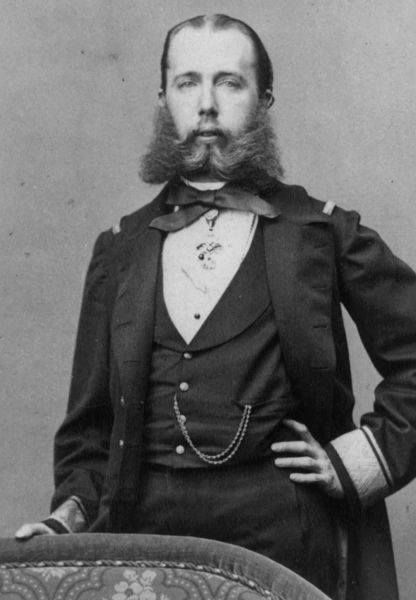
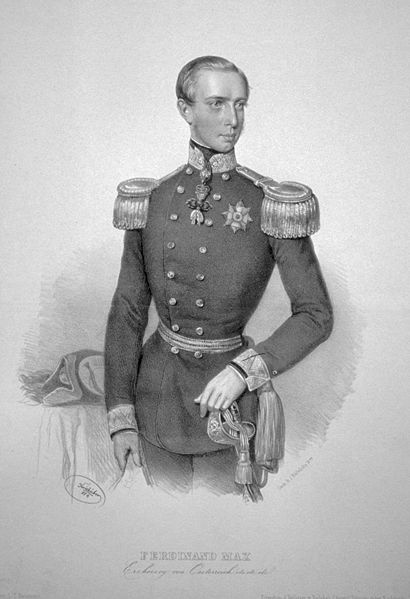
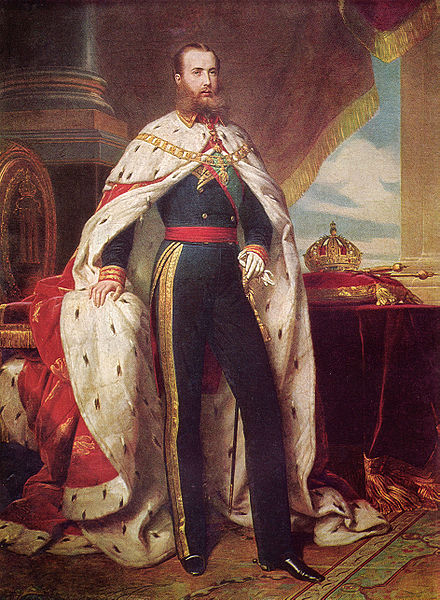
Maximilian I of Mexico (6 July 1832 – 19 June 1867; born Archduke Ferdinand Maximilian Joseph of Austria) was a member of the Imperial House of Habsburg - Lorraine who is best known for his association with the Second Mexican Empire.
After a distinguished career in the Austrian Navy, he was proclaimed Emperor of Mexico on 10 April 1864 during the Second Mexican Empire with the backing of Napoleon III of France and a group of Mexican monarchists who sought to revive the Mexican monarchy. Many foreign governments, including that of the United States, refused to recognize his government. This helped to ensure the success of Liberal forces led by Benito Juárez, and Maximilian was executed, after capture by the Liberals, in 1867. In Mexico, he and his consort are known as Maximiliano and Carlota. The future emperor of Mexico was born at Schönbrunn Palace, Vienna, Austria, the second son of Archduke Franz Karl of Austria and his wife Sophie Friederike Dorothee Wilhelmine, Princess of Bavaria. His siblings were Archduke Franz Josef (later Emperor Franz Josef I of Austria), Archduke Karl Ludwig, Archduchess Maria Anna Caroline Pia and Archduke Ludwig Viktor. He was born with the full title His Imperial and Royal Highness Ferdinand Maximilian Joseph, Prince Imperial and Archduke of Austria, Prince Royal of Hungary and Bohemia. He was widely known as Archduke Ferdinand Max. There
is well documented suspicion that Ferdinand Max was not the product of
a union between Princess Sophie and Franz Karl. Many Europeans, and
Viennese in particular, suspected that he was actually fathered by Napoleon II (son of Napoleon I and Marie Louise of Austria as
Napoleon François Joseph Charles Bonaparte, also known as the
Duke of Reichstadt). Those who subscribe to this belief cite the
unnaturally close relationship that existed between Sophie and Napoleon II (it was said that Sophie never recovered after his death and that she blamed it on Metternich for
the rest of her life) and that, from birth, Maximilian's stature
resembled Napoleon II's more than that of Franz Karl, his older
brother, or any of his younger brothers.
Ferdinand
Max was a particularly clever boy who displayed considerable culture in
his taste for the arts, and he demonstrated an early interest in
science, especially botany. When he entered military service, he was trained in the Austrian Navy. He threw himself into this career with so much zeal that he quickly rose to high command. In
his political views, Archduke Ferdinand Max was very much influenced by
the progressive ideas in vogue at the time. He had a reputation as a liberal, and this led, in February 1857, to his appointment as viceroy of the Kingdom of Lombardy - Venetia. On 27 July 1857, in Brussels (Belgium) Archduke Ferdinand Max married his second cousin, Princess Charlotte of Belgium (later known as Empress Carlota of Mexico), the daughter of Leopold I, King of the Belgians and Louise - Marie of France. She was first cousin to both Queen Victoria and Prince Albert. Ferdinand Max and Charlotte had no children. They lived as the Austrian regents in Milan or Viceroys of Lombardy - Venetia from
1857 until 1859, when Emperor Franz Josef dismissed Ferdinand Max from
this post. The emperor was angered by the liberal policies pursued by
his brother in Italy. Shortly after his dismissal, Austria lost control
of most of its Italian possessions. Ferdinand Max then retired to
Trieste, near which he built the castle Miramare.
In 1859, Ferdinand Maximilian was first approached by Mexican monarchists — members of the Mexican aristocracy, led by local nobleman José Pablo Martínez del Río — with a proposal to become the Emperor of Mexico. He did not accept at first, but sought to satisfy his restless desire for adventure with a botanical expedition to the tropical forests of Brazil. However, after the French intervention in Mexico, under pressure from Napoleon III and after General Élie - Frédéric Forey's capture of Mexico City and the plebiscite which
confirmed his proclamation of the empire, he consented to accepting the
crown in 1863 (Ferdinand Maximilian was not told of the dubious nature
of the plebiscite, which was held while French troops were occupying
most of the territory). His decision involved the loss of all his
nobility rights in Austria, though he was not informed of this until
just before he left. Archduchess Charlotte was thereafter known as "Her
Imperial Majesty Empress Carlota". In
April 1864, Archduke Ferdinand Maximilian conceded his duties as
Commander - in - Chief of the Austrian Navy. He traveled from Trieste aboard the SMS Novara, escorted by the frigates SMS Bellona (Austrian) and Themis (French), and the Imperial yacht Phantasie led the warship procession from his palace at Miramare out to sea. The new emperor of Mexico landed at Veracruz on 21 May 1864 with the backing of Mexican conservatives and Napoleon III, but from the very outset he found himself involved in serious difficulties since the Liberal forces led by President Benito Juárez refused to recognize his rule. There was continuous warfare between his French troops and the Republicans. The Imperial couple chose as their seat Mexico City. The Emperor and Empress set up their residence at Chapultepec Castle, located on the top of a hill formerly at the outskirts of Mexico City that had been a retreat of Aztec emperors. Maximilian ordered a wide avenue cut through the city from Chapultepec to the city center; originally named Paseo de la Emperatriz, it is today Mexico City's famous boulevard, Paseo de la Reforma. They made plans to be crowned at the Catedral Metropolitana but, due to the constant instability of the regime, the coronation was never carried out. As Maximilian and Carlota had no children, they adopted Agustín de Iturbide y Green and his cousin Salvador de Iturbide y de Marzán, both grandsons of Agustín de Iturbide,
who had briefly reigned as Emperor of Mexico in the 1820s. They gave
young Agustín the title of "His Highness, the Prince of
Iturbide" and intended to groom him as heir to the throne. To
the dismay of his conservative allies, Maximilian upheld several
liberal policies proposed by the Juárez administration – such as
land reforms, religious freedom, and extending the right to vote beyond
the landholding class. At first, Maximilian offered Juárez an
amnesty if he would swear allegiance to the crown, even offering the
post as Prime Minister, which Juárez refused. Later, Maximilian
ordered all captured followers of Juárez to be shot, in response
to the Republican practice of executing anyone who was a supporter of
the Empire. In the end, it proved to be a tactical mistake that only
exacerbated opposition to his regime. After the end of the American Civil War, the United States began supplying partisans of Juárez and his ally Porfirio Diaz by "losing" arms depots for them at El Paso del Norte at
the Mexican border. Meanwhile, Maximilian invited ex-Confederates to
move to Mexico in a series of settlements called the "Carlota Colony"
and the New Virginia Colony with a dozen others being considered, a plan conceived by the internationally renowned U.S. Navy oceanographer and inventor Matthew Fontaine Maury. Maximilian also invited settlers from "any country" including Austria and the other German states. Nevertheless, by 1866, the imminence of Maximilian's abdication seemed
apparent to almost everyone outside Mexico. That year, Napoleon III
withdrew his troops in the face of Mexican resistance and U.S.
opposition under the Monroe Doctrine, as well as increasing his military contingent at home to face the ever growing Prussian military and Bismarck. Carlota travelled to Europe, seeking assistance for her husband's regime in Paris and Vienna and, finally, in Rome from Pope Pius IX.
Her efforts failed, and she suffered a deep emotional collapse and
never went back to Mexico. After her husband was executed by
Republicans the following year, she spent the rest of her life in
seclusion, first at Miramare Castle near Trieste, Italy, and then at Bouchout Castle in Meise, Belgium, where she died on 19 January 1927.
Though
urged to abandon Mexico by Napoleon III himself, whose troop withdrawal
from Mexico was a great blow to the Mexican Imperial cause, Maximilian
refused to desert his followers. Maximilian allowed his followers to
determine whether or not he abdicated. Faithful generals such as
Miguel Miramon, Leonardo Márquez, and Tomás Mejía vowed to raise an army that would challenge the invading Republicans. Withdrawing, in February 1867, to Santiago de Querétaro, he sustained a siege for
several weeks, but on May 11 resolved to attempt an escape through the
enemy lines. This plan was sabotaged by Colonel Miguel López,
who was bribed by the Republicans to open a gate and lead a raiding
party
though with the agreement that Maximilian would be allowed to escape. The
city fell on 15 May 1867 and Maximilian was captured the next morning
after the failure of a courageous attempt to break through Republican
lines by a loyal hussar cavalry brigade led by Felix Salm-Salm. Following a court martial, he was sentenced to death. Many of the crowned heads of Europe and other prominent figures (including the eminent liberals Victor Hugo and Giuseppe Garibaldi) sent telegrams and letters to Mexico pleading for the Emperor's life to
be spared. Although he liked Maximilian on a personal level, Juárez
refused to commute the sentence, believing that it was necessary to
send a message that Mexico would not tolerate any government imposed by
foreign powers. The sentence was carried out in the Cerro de las Campanas on
June 19, 1867 when Maximilian, along with Generals Miramón and
Mejía, was executed by a firing squad. His last words were, "Mexicanos!
I die in a just cause... the independence and liberty of Mexico. May my
blood be the last to flow for the good of this land. Viva Mexico!"
After his execution, Maximilian's body was embalmed and displayed in Mexico. Early the following year, the Austrian admiral Wilhelm von Tegetthoff was sent to Mexico aboard the SMS Novara to take the former emperor's body back to Austria. After arriving in Trieste, the coffin was taken to Vienna and buried in the Imperial Crypt.
